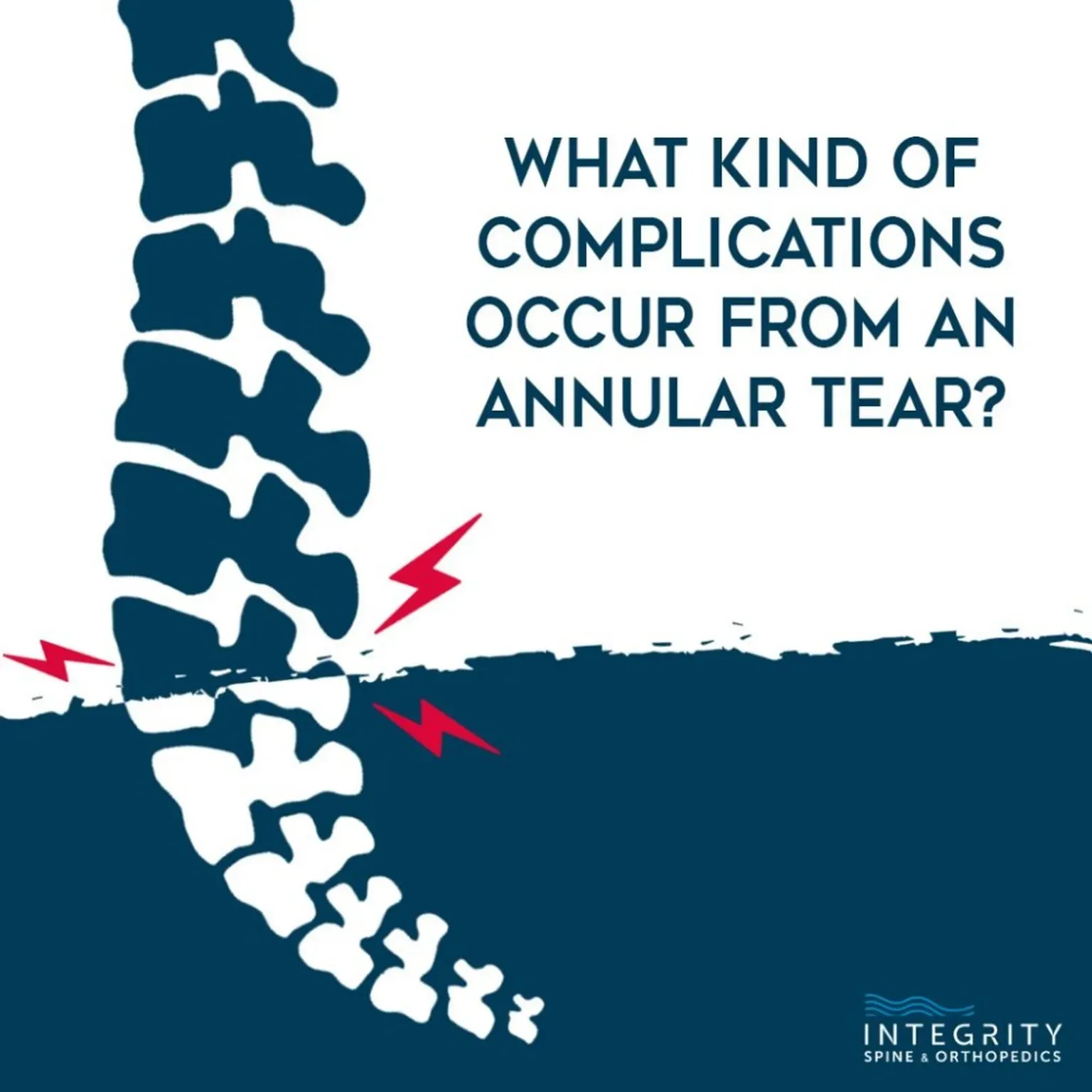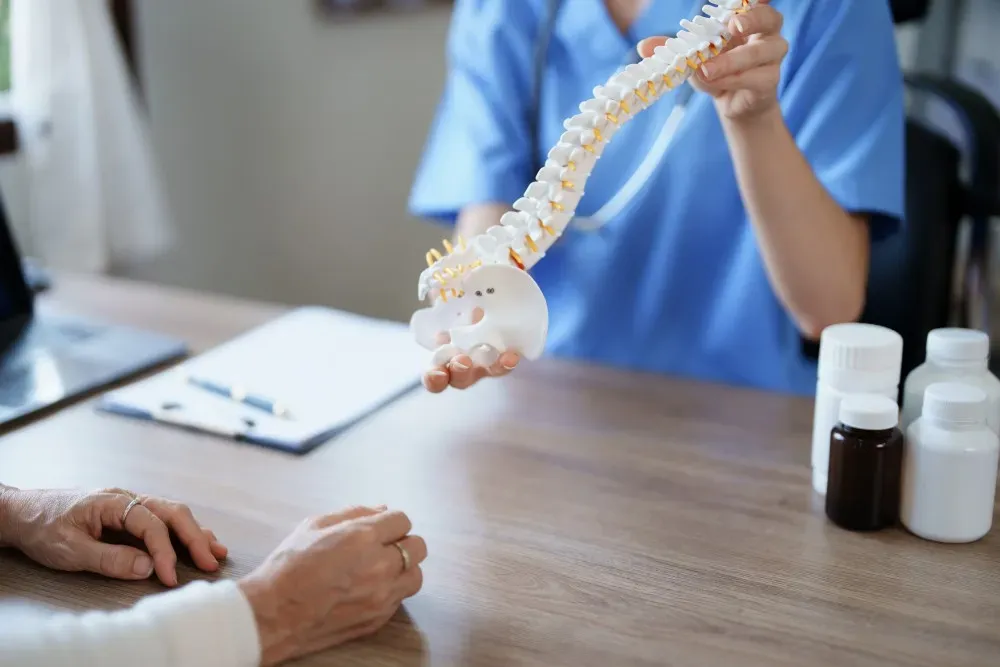Neurosurgery & Orthopedic Surgeons in Jacksonville

What Kinds of Complications Occur From an Annular Tear?
An annular tear is an injury that occurs to one of the intervertebral spinal discs. Spinal discs sit between each vertebrae in the spine. They cushion and support the spinal bones, absorb shock, and help the spine move, bend and twist flexibly.
An annular tear is an injury that occurs to one of the intervertebral spinal discs. Spinal discs sit between each vertebrae in the spine. They cushion and support the spinal bones, absorb shock, and help the spine move, bend and twist flexibly. Each disc is made of an inner, jelly-like nucleus (nucleus pulposus) surrounded by a tough outer ring of ligaments (annulus fibrosus).
When a tear develops in a spinal disc’s outer ring, the injury is called an annular tear. Natural degeneration from aging is a common cause of annular tears. As we age, our spinal discs become drier, stiffer, weaker and more prone to tears and injuries. Repetitive lifting or twisting motions, a traumatic injury, and excess body weight can also cause annular tears.
Small or mild tears may not even be noticeable or cause pain. But in many cases, disc tears cause significant neck or back pain and loss of movement in the spine. Keep reading to learn complications that can develop as annular tears progress in severity.
4 COMPLICATIONS THAT CAN DEVELOP FROM AN ANNULAR TEAR
Without proper care and treatment, an annular tear will continue to worsen. When that happens, the following complications can occur.
- Herniated disc. Continued stress and pressure from daily activities, sports, or heavy lifting can eventually cause a torn disc to herniate. Disc herniation occurs when the jelly-like nucleus leaks out of the tear and into the spinal canal. A herniated disc can cause intense back or neck pain, nerve compression, and other symptoms.
- Nerve compression. When a torn disc bulges out of place or herniates, disc material can press against nearby spinal nerves, causing symptoms like pain, numbness, tingling and weakness in the arms or legs. Sciatica is a common side effect of annular tears and herniated discs. Sciatica occurs when the sciatic nerve in the lumbar spine is irritated, pinched or compressed. It causes one-sided pain that radiates from the low back down the buttock, thigh, calf, and foot.
- Future tears. Once you’ve suffered one annular tear, you’re at greater risk for developing future tears and disc injuries. A tear can accelerate the rate of disc degeneration.
- Chronic pain. Left untreated, annular tears can be the cause of significant, chronic back or neck pain.
HOW ARE ANNULAR TEARS TREATED?
Many annular tears heal on their own with conservative treatments and lifestyle changes. Your physician-prescribed treatment plan could include the following:
- Medications. Over-the-counter NSAIDs (ibuprofen, naproxen, aspirin) can help ease mild pain, reduce inflammation and reduce swelling. Your doctor may prescribe stronger painkillers if your pain is severe and over-the-counter medications aren’t effective.
- Corticosteroid injections. A cortisone solution injected directly into the spine can relieve painful inflammation and swelling around irritated nerve roots. Corticosteroid injections provide short-term pain relief for several weeks or months. During that time, you can start physical therapy, return to normal mobility, and give your body time to start healing.
- Physical therapy. Physical therapy can help you improve strength and flexibility in the back, core and leg muscles that support the spine. Strengthening your core will take pressure off the spine and prevent future injuries. A therapist will also help you improve your posture and body mechanics to prevent future injuries.
- Alternative treatments. Chiropractic care, massage therapy, or acupuncture may help you find pain relief.
If an annular tear continues to cause significant pain after conservative treatment, or if the spinal disc herniates and presses against a spinal nerve, spine surgery may be necessary. But new, minimally invasive surgical techniques are making spine surgery safer than ever before.
Some annular tears can be sealed with a laser procedure. Other minimally invasive surgery options include a discectomy, total disc replacement, or spinal fusion. Minimally invasive surgery requires smaller incisions, causes less muscle and tendon damage and results in less post-op pain and stiffness. These surgeries have shorter recovery periods, meaning you can get back to work and normal activities faster.
TIPS FOR PREVENTION
There are several things you can do at home to reduce your risk of back injuries and annular tears.
- Exercise. Regular exercise is the key to maintaining strong and flexible bones, joints, and muscles. Keep your core muscles strong to reduce excess pressure on the spine. Low-impact exercises like walking, bicycling, swimming, and yoga are great choices that are also gentle on the joints.
- Stretch. Take time during the day to perform gentle stretches that relieve pressure on the spine and loosen tight back muscles. And remember to always stretch before and after exercising.
- Watch your weight. Excess weight places a lot of stress on the spine, increasing the chance of injury. If you aren’t within a healthy weight range, work with your doctor to find a weight management program that works with your lifestyle.
- Quit smoking. Smoking is incredibly damaging to every part of your body. Research suggests that smoking weakens spinal discs and increases the rate of degeneration.
- Practice good posture. Practice proper posture for standing, sitting, walking and sleeping to reduce pressure on the spine and spinal discs.
- Move during the day. Sitting for long periods of time is one of the worst things you can do for your spine health and overall health. Prolonged sitting weakens the muscles, ligaments and tendons that support the back and places more pressure on the spine. Get up and move at least once an hour throughout the day. Take a bathroom break, refresh your coffee, or take a few laps around your home or office.
CONTACT INTEGRITY SPINE AND ORTHOPEDICS FOR BACK CARE AND TREATMENT
Whether you’re suffering from an acute injury or chronic pain, Integrity Spine and Orthopedics has the orthopedic care, pain management, sports medicine, and minimally invasive surgery services to help you to get back on your feet and back to doing the activities you love.
Call us today or reach out online to schedule your first appointment.




